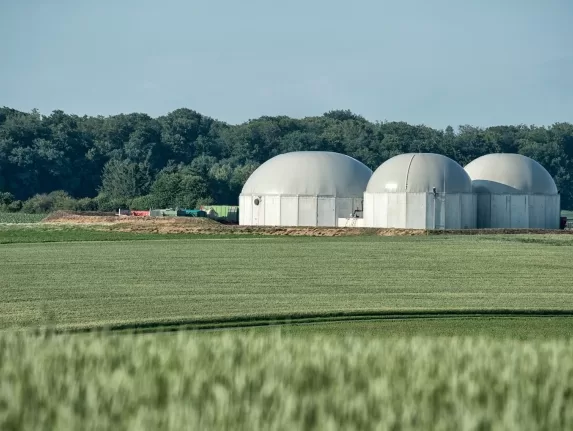Explore the power of Biomass Energy in our comprehensive guide. Learn about its definition, history, types (e.g., direct combustion, co-firing, pyrolysis, anaerobic digestion, biochemical conversion), and advantages (renewable, carbon-neutral, waste reduction, energy security). Discover potential drawbacks (spatial requirements, pollution risks, impact on food supply). Understand its role in combatting climate change, reducing greenhouse gas emissions, and driving sustainability.

Introduction to Biomass Energy
We derive biomass energy, also known as bioenergy, from organic materials like plants and animals. We can use biomass as a source of heat, convert it into biofuel for transportation, or use it to generate electricity.
Definition of Biomass Energy
Organic material, often referred to as feedstock, produces biomass energy. This feedstock comprises different types of plant or animal materials such as tree wood, agricultural or forestry residues, and the organic components of municipal and industrial wastes. We can even harness the fumes from landfills as a source of biomass energy.
History of Biomass Energy
The use of biomass for energy purposes dates back to when our ancestors first discovered fire, possibly as far back as a million years ago. For the vast majority of human history, biomass was the dominant energy source.
In the industrialized world, biomass energy was gradually replaced by coal, oil, and gas. However, in recent decades, due to growing concerns about climate change and the need for sustainable energy sources, there has been a resurgence in interest in biomass energy.
Types of Biomass
There are several types of materials that can be considered biomass:
- Wood and agricultural products: This category encompasses residues like dead trees, branches, tree stumps, yard clippings, wood chips, and even municipal solid waste.
- Food, yard, and wood waste in garbage: As raw biomass, these materials can undergo processing to produce various types of bioenergy, including biofuels and biogas.
- Algae: Algae, being photosynthetic, holds promise as a biofuel source.
- Energy crops: These crops are specifically grown for use as fuel, offering high output per hectare with low input energy.
- Animal manure and human sewage: These materials can be converted to biogas through anaerobic digestion or transformed into solid biofuels through drying processes.

Production of Biomass Energy
Biomass energy is produced using several methods, each with its own set of benefits and challenges. Here’s a rundown of the key methods:
Direct Combustion
This is the simplest and most common method of generating energy from biomass. We burn biomass materials like wood pellets, agricultural waste, or dried manure to produce heat. We can use this heat directly for heating or cooking, or to generate electricity by heating water to create steam. This steam then powers a turbine connected to an electrical generator.
Co-firing
Co-firing involves combusting biomass and coal together in one furnace, enabling power plants to produce electricity with fewer greenhouse gas emissions than coal alone. This cost-effective method reduces carbon emissions in existing coal power plants without major infrastructure modifications.
Pyrolysis
Pyrolysis is the thermal decomposition of biomass at high temperatures (typically above 500°C) in the absence of oxygen. This process produces a mixture of combustible gases (known as syngas), bio-oil, and a solid residue called biochar. We can burn the syngas and bio-oil to produce electricity or refine them into other products. Additionally, we can use the biochar as a soil amendment or for carbon sequestration.
Anaerobic Digestion
Anaerobic digestion involves the breakdown of biomass by microorganisms in an oxygen-free environment. The process produces biogas (a mixture of methane and carbon dioxide) and a nutrient-rich digestate. We can use the biogas for heat and electricity production, while the digestate serves as a fertilizer.
Biochemical Conversion
Biochemical conversion processes use enzymes, bacteria, or other microorganisms to break down biomass into various products, including biogas, biofuels like ethanol or biodiesel, and other chemicals. These processes typically include fermentation (where microorganisms break down sugars into ethanol or other products), anaerobic digestion, and the production of biodiesel from plant oils or animal fats.

Advantages of Biomass Energy
Biomass energy has several significant advantages that make it an important part of a sustainable energy future:
Renewable Nature
Biomass is a renewable energy source because we can always grow more trees and crops, and waste will always exist. It is a resource that is abundant and replenishable in a human timescale, making it a sustainable choice in energy production.
Carbon Neutrality
People often consider biomass energy as carbon neutral. The idea suggests that the plants absorb the carbon dioxide released during biomass combustion while growing. Although the production and transport of biomass fuels result in some emissions, the net carbon emissions can be very low compared to fossil fuels.
Waste Reduction
Using waste materials for biomass energy production can help to reduce the amount of waste going to landfills and incinerators. Biomass energy plants can use a wide range of waste materials including forestry residues, agricultural waste, and organic components of municipal and industrial wastes.
Energy Security
Biomass energy can contribute to energy security by providing an alternative to fossil fuels. Unlike oil, gas, or coal, which are concentrated in certain regions, biomass can be produced in almost any climate or geographical location. This reduces reliance on fossil fuel imports, which are subject to price volatility and supply disruption.
It’s important to note that while biomass energy has these advantages, it also has its challenges and potential downsides. These include the need for significant land and water resources, potential competition with food production, and air pollution issues if not properly managed. Therefore, sustainable and responsible practices are crucial in biomass energy production.
Disadvantages of Biomass Energy
While biomass energy has numerous benefits, there are also certain disadvantages that need to be considered:
Spatial Requirements
Large amounts of land are required to cultivate energy crops or collect biomass, which can lead to deforestation and habitat loss if not managed sustainably. Additionally, the infrastructure for biomass energy production, such as power plants and storage facilities, also requires considerable space.
Pollution Risks
Burning biomass for energy can release harmful pollutants into the air, including particulate matter, nitrogen oxides, and sulfur dioxide, which can contribute to health problems and environmental damage. However, modern technologies and proper regulation can help to mitigate these risks.
Impact on Food Supply
If agricultural land is used to grow energy crops instead of food crops, it could potentially lead to food shortages or increased food prices. This is particularly a concern in regions where arable land is scarce, and food security is already an issue.
High Initial Costs
The upfront costs for setting up biomass energy facilities can be quite high, making it a significant barrier for many countries and organizations. This includes the cost of land, cultivation, harvesting, transportation of biomass, and the construction of power plants. However, once established, the operational costs can be lower compared to some other forms of energy.
Despite these challenges, continuous advancements in technology and sustainable management practices are helping to make biomass energy more efficient, less polluting, and more cost-effective. It’s crucial to ensure a balanced approach to biomass energy development that maximizes its benefits while minimizing its downsides.

Biomass Energy and Climate Change
The development and use of biomass energy can play a crucial role in addressing climate change. Here’s how:
Reduction of Greenhouse Gas Emissions
Biomass energy is often considered carbon neutral or low-carbon because burning biomass releases carbon dioxide, which is balanced by plants absorbing carbon dioxide during their growth. In contrast, fossil fuels add to atmospheric carbon dioxide, contributing to global warming.
Additionally, biomass energy, utilizing waste materials, helps prevent methane emissions from waste decomposition—a potent greenhouse gas.
However, the carbon neutrality of biomass energy is debated. It depends on factors like biomass type, time frame, and sourcing and processing methods.
Role in Combating Climate Change
Biomass energy can play a significant role in the transition to a low-carbon energy system. By replacing fossil fuels in electricity generation, heating, and transportation, biomass energy can help to reduce overall greenhouse gas emissions.
Certain forms of biomass energy, like bioenergy with carbon capture and storage (BECCS), may lead to negative emissions, removing more carbon dioxide from the atmosphere than emitted.
To effectively mitigate climate change, we must source and use biomass sustainably and responsibly, considering factors like biodiversity, soil health, and the rights of local communities.

Biomass Energy Technologies
There are various technologies to convert biomass into energy, each suitable for different types of biomass and end uses:
Direct Combustion Technology
Direct combustion, the most common method for generating heat from biomass, involves burning biomass in a boiler to generate steam. This steam then turns a turbine to generate electricity, or the heat produced can serve industrial processes or district heating. This technology, well-established and highly efficient, accommodates a wide range of biomass types.
Gasification Systems
Gasification transforms organic or fossil-based carbonaceous materials into carbon monoxide, hydrogen, and carbon dioxide. It occurs at high temperatures without combustion, using controlled oxygen and/or steam. The resulting gas mixture, called syngas, generates electricity, provides heat, or serves as a basic chemical in petrochemical and refining industries.
Anaerobic Digesters
Anaerobic digestion involves a series of biological processes where microorganisms break down biodegradable material in the absence of oxygen. When we combust the resulting biogas from the process, it generates electricity and heat or we can process it into renewable natural gas and transportation fuels. We can use various types of organic waste in anaerobic digestion systems, including manure, food waste, and sewage sludge.
Pyrolysis Systems
Pyrolysis refers to the thermal decomposition of organic material at elevated temperatures in the absence of oxygen. It involves a simultaneous change of chemical composition and physical phase, and is irreversible. The process results in three products: gas (syngas), liquid (bio-oil), and solid (char). Syngas can generate electricity, while bio-oil can be further processed into fuels. Biochar can be used as a soil amendment or for carbon sequestration.
The choice of technology depends on factors like the type of biomass available, the desired end product, cost considerations, and local environmental regulations.

Economics of Biomass Energy
Biomass energy can play an essential role in diversifying the energy mix and decreasing dependency on fossil fuels, but its economics are complex and influenced by many factors:
Cost of Production
The cost of biomass energy production depends on feedstock cost, technology, scale, and local regulations and markets. Feedstock costs vary greatly, ranging from negative (waste disposal fees) to high (specially grown energy crops). The capital and operational costs of biomass energy facilities can also be significant.
Economic Benefits
Biomass energy can offer various economic benefits. It can generate jobs and stimulate economic activity in rural areas where biomass resources are often located. By reducing dependency on imported fuels, it can also improve energy security and balance of trade. Furthermore, by providing a use for waste products, biomass energy can reduce waste disposal costs and create new revenue streams.
Market Dynamics
Factors like energy prices, policy incentives, technological developments, and societal attitudes towards energy and the environment influence the market for biomass energy. For instance, if fossil fuel prices are high or if there are strong policy incentives for renewable energy, the market for biomass energy can be more favorable.
Future Economic Outlook
As global efforts to combat climate change and shift to a more sustainable and diversified energy system continue, we anticipate the demand for biomass energy to rise. Yet, addressing challenges related to resource availability, sustainability, and cost competitiveness remains crucial.
Moreover, integrated approaches, such as biorefineries that produce multiple products (e.g., energy, fuels, and chemicals) from biomass, can enhance the overall economic viability and improve the economics of biomass energy.

Policy and Regulation in Biomass Energy
Policy and regulatory frameworks are crucial in shaping the development and deployment of biomass energy. They can have significant impacts on the viability, sustainability, and social acceptability of biomass energy systems:
Current Policies
Current policies on biomass energy vary widely between different countries and regions. In many places, policy support for biomass energy is part of broader renewable energy or climate change policies. Such support can take various forms, including feed-in tariffs, renewable portfolio standards, tax incentives, direct subsidies, and carbon pricing mechanisms. Policies can also promote the use of waste materials for energy or the development of advanced biofuels.
Regulatory Challenges
Regulatory challenges for biomass energy include ensuring sustainability, managing competition for resources, and addressing local environmental and social impacts. Policies need to carefully balance the promotion of biomass energy with considerations for land use, biodiversity, water resources, and social equity. Regulations also need to keep pace with technological developments and evolving scientific understanding.
International Regulations
On the international level, regulations and agreements related to climate change, trade, and sustainability can significantly influence biomass energy. For example, the Paris Agreement on climate change encourages the use of renewable energy, including biomass. Trade agreements can affect the international trade of biomass and biofuels, while sustainability certification schemes can influence the market for sustainable biomass products.
Future Policy Trends
The global push to combat climate change, ensure energy security, and embrace the circular economy concept will influence future policy trends in biomass energy. Expect policies promoting sustainable and efficient biomass use, supporting innovation, and integrating biomass energy across agriculture, waste management, and industry.
Design and implementation of policy and regulatory frameworks for biomass energy must prioritize a fair and just transition to a low-carbon economy, respecting the needs and rights of all stakeholders, including local communities and workers.
Future of Biomass Energy
Various trends and developments are expected to influence the future of biomass energy.
Emerging Trends
Emerging trends include recognizing biomass’s role in the circular economy, valuing waste as a resource, and integrating biomass energy with various sectors like agriculture, industry, and waste management.
There’s also a rising emphasis on sustainable and responsible biomass sourcing, addressing land use, biodiversity, and social equity concerns. This could drive the development of sustainability standards and certification schemes for biomass and biofuels.
Advances in Technology
Technological advancements are expected to improve the efficiency, sustainability, and cost-effectiveness of biomass energy. For example, advancements in gasification and pyrolysis technologies could allow for the production of advanced biofuels and biochemicals from biomass. Progress in carbon capture and storage technologies could also enable bioenergy with carbon capture and storage (BECCS), which can potentially achieve negative emissions.
Potential for Growth
The potential for growth in biomass energy is significant, especially in regions with abundant biomass resources and strong policy support. Biomass energy can play an important role in diversifying the energy mix, enhancing energy security, and reducing greenhouse gas emissions. However, it’s crucial to ensure that this growth is sustainable and does not lead to negative environmental or social impacts.
Future Challenges
Future challenges for biomass energy include managing competition for resources, ensuring sustainability, reducing costs, and gaining social acceptance. Addressing these challenges will require a combination of policy support, technological innovation, sustainable practices, and public engagement.
Overall, the future of biomass energy looks promising, but its realization will depend on the collective efforts of various stakeholders, including governments, industry, researchers, communities, and consumers.